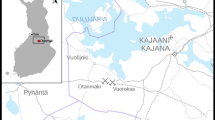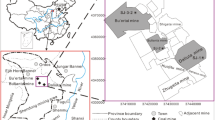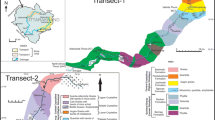Abstract
Geotechnical characteristics and relationships between various physical and mechanical properties were assessed for eight types of hornfelsic rock collected from southern and southwestern parts of the city of Hamedan in western Iran. Rock samples were subjected to mineralogical, physical, index, and mechanical laboratory tests and found to contain quartz, feldspar, biotite, muscovite, garnet, sillimanite, kyanite, staurolite, graphite, and other fine-grained cryptocrystalline matrix materials. Samples had a porphyroblastic texture, and the mineral contents and physical properties influenced various rock characteristics. Some rock characteristics were affected by mineral content, while others were affected by porosity. Dry unit weight, primary and secondary wave velocities, and slake-durability index were noteworthy characteristics affected by mineral content, while porosity had the greatest influence on water absorption, Schmidt hardness, point load index, Brazilian tensile strength, and uniaxial compressive strength. Empirical equations describing the relationships between different rock parameters are proposed for determining the essential characteristics of rock, such as secondary wave velocity, slake-durability index, point load index, Brazilian tensile strength, and uniaxial compressive strength. On the basis of these properties, the studied rocks were classified as being strong or very strong.













Similar content being viewed by others
Abbreviations
- γ d :
-
Dry unit weight (g/cm3)
- γ sat :
-
Saturated unit weight (g/cm3)
- G s :
-
Specific gravity
- n :
-
Porosity (%)
- W a :
-
Water absorption (%)
- v p :
-
Primary wave velocity (m/s)
- v s :
-
Secondary wave velocity (m/s)
- Id:
-
Slake-durability index (%)
- H s :
-
Schmidt hardness
- I s(50) :
-
Point load index (MPa)
- BTS:
-
Brazilian tensile strength (MPa)
- UCS:
-
Uniaxial compressive strength (MPa)
- HDR:
-
Heydareh
- ABD:
-
Abbas-Abad
- CMK:
-
Cheshmeh-Malek
- FGR:
-
Faghireh
- PSK1:
-
Piste-Eski1
- PSK2:
-
Piste-Eski2
- SHR1:
-
Shahrestaneh1
- SHR2:
-
Shahrestaneh2
- E :
-
Elasticity modulus (dynamic) (GPa)
- G :
-
Shear modulus (dynamic) (GPa)
- ν :
-
Poisson’s ratio (dynamic)
- K :
-
Bulk modulus (dynamic) (GPa)
References
Andrade PS, Saraiva AA (2010) Physical and mechanical characterization of phyllites and metagreywackes in central Portugal. Bull Eng Geol Environ 69:207–214
ASTM (1990) Standard test method for slake durability of shales and similar weak rocks (D4644). Annual Book of ASTM Standards, vol. 4.08. ASTM, Philadelphia, pp 863–865
ASTM (1995) Standard test method for unconfined compressive strength of intact rock core specimens. ASTM standards on disc 04.08; Designation D2938
ASTM (1996) Standard test method for laboratory determination of pulse velocities and ultrasonic elastic constants of rock. Designation: D2845–D2895
ASTM (2001a) Standard method for determination of the point load strength index of rock. ASTM standards on disc 04.08, Designation, D5731
ASTM (2001b) Standard test method for splitting tensile strength of intact rock core specimens. ASTM standards on disc 04.08, Designation, D3967
ASTM (2001c) Standard test method for determination of rock hardness by rebound hammer method. ASTM standards on disc 04.09, D5873-D5880
Aydin A (2009) ISRM suggested method for determination of the Schmidt hammer rebound hardness: revised version. Int J Rock Mech Min Sci 46:627–634
Bandini A, Berry P (2013) Influence of marble’s texture on its mechanical behavior. Rock Mech Rock Eng 46(4):785–799
Barla G, Innaurato N (1973) Indirect tensile strength of anisotropic rocks. Rock Mech 5:215–230
Bell FG (1993) Engineering geology. Blackwell Scientific Publications, London
Brattli B (1992) The influence of geological factors on the mechanical properties of basic igneous rocks used as road surface aggregates. Eng Geol 33:31–44
Broch E, Franklin JA (1972) The point load strength test. Int J Rock Mech Min Sci 9:669–697
Cargill JS, Shakoor A (1990) Evaluation of empirical methods for measuring the uniaxial compressive strength of rock. Int J Rock Mech Min Sci Geomech Abstr 27(6):495–503
Dhakal G, Yoneda T, Kato M, Kaneko K (2002) Slake durability and mineralogical properties of some pyroclastic and sedimentary rocks. Eng Geol 65:31–45
Ersoy A, Waller MD (1995) Textural characterization of rocks. Eng Geol 39:123–136
Fereidooni D, Khanlari GR, Heidari M, Sepahi-Gero AA, Kolahi-Azar AP (2015) Assessment of inherent anisotropy and confining pressure influences on mechanical behavior of anisotropic foliated rocks under triaxial compression. Rock Mech Rock Eng. doi:10.1007/s00603-015-0814-y
Franklin JA, Chandra R (1972) The slake-durability test. Int J Rock Mech Min Sci 9:325–341
Gamble JC (1971) Durability-Plasticity classification of shales and other argillaceous rocks: Ph.D. Thesis, University of Illinois, Urbana-Champaign, IL, p 161
Goodman RE (1989) Introduction to rock mechanics. Wiley, New York, p 562
Gupta V, Ahmed I (2007) The effect of pH of water and mineralogical properties on the slake durability (degradability) of different rocks from the Lesser Himalaya, India. Eng Geol 95:79–87
IAEG (1979) Classification of rocks and soils for engineering geological mapping, Part 1: rock and soil materials. Rep Comm Eng Geol Mapp Bull Int Assoc Eng Geol 19:364–371
ISRM (1978) Suggested methods for determining tensile strength of rock materials. Int J Rock Mech Min Sci Geomech Abstr 15(3):99–103
ISRM (1979) Suggested methods for determining the uniaxial compressive strength and deformability of rock materials. Int J Rock Mech Min Sci Geomech Abstr 16:135–140
ISRM (1981) Suggested methods for determining hardness and abrasiveness of rocks, Part 3. Commission on standardization of laboratory and field tests, pp 101–112
ISRM (1985) Suggested method for determining point load strength. Int J Rock Mech Min Sci Geomech Abstr 22:51–60
ISRM (2007) The Blue Book: the complete ISRM suggested methods for rock characterization, testing and monitoring, 1974–2006. In: Ulusay R, Hudson JA (eds) Compilation arranged by the ISRM Turkish National Group, Ankara, Turkey. Kazan Offset Press, Ankara
Kahraman S, Gunaydin O (2009) The effect of rock classes on the relation between uniaxial compressive strength and point load index. Bull Eng Geol Environ 68:345–353
Khanlari GR, Heidari M, Sepahi-Gero AA, Fereidooni D (2014a) Determination of geotechnical properties of anisotropic rocks using some index tests. Geotech Test J 37(2):1–13
Khanlari GR, Heidari M, Sepahi-Gero AA, Fereidooni D (2014b) Quantification of strength anisotropy of metamorphic rocks of the Hamedan Province, Iran, as determined from Cylindrical Punch, Point Load and Brazilian tests. Eng Geol 169:80–90
Kilic A, Teymen A (2008) Determination of mechanical properties of rocks using simple methods. Bull Eng Geol Environ 67:237–244
Li D, Wong LNY (2013) The Brazilian disc test for rock mechanics applications: review and new insights. Rock Mech Rock Eng 46:269–287
Melbouci B, Bahar R, Cambou B (2008) Study of the behavior of schist grains under crushing. Bull Eng Geol Environ 67:209–218
Merriam R, Rieke HH, Kim YC (1970) Tensile strength related to mineralogy and texture of some granitic rocks. Eng Geol 4:155–160
Onodera TF, Asoka Kumara HM (1980) Relation between texture and mechanical properties of crystalline rocks. Bull Int Assoc Eng Geol 22:173–177
Shakoor A, Bonelli RE (1991) Relationship between petrographic characteristics, engineering index propertiesand mechanical properties of selected sandstone. Bull Int Assoc Eng Geol XXVIII(1):55–71
Shalabi FI, Cording EJ, Al-Hattamleh OH (2007) Estimation of rock engineering properties using hardness tests. Eng Geol 90:138–147
Singh VK, Singh D, Singh TN (2001) Prediction of strength properties of some schistose rocks from petrographic properties using artificial neural networks. Int J Rock Mech Min Sci 38:269–284
Tugrul A, Zarif IH (1999) Correlation of mineralogical and textural characteristics with engineering properties of selected granitic rocks from Turkey. Eng Geol 51:303–317
Vernik L, Buno M, Bovberg C (1993) Empirical relations between compressive strength and porosity of siliciclastic rocks. Int J Rock Mech Min Sci Geomech Abstr 30(7):677–680
Willard RJ, McWilliams JR (1969) Microstructural techniques in the study of physical properties of rock. Int J Rock Mech Min Sci 6:1–12
Yilmaz I, Sendir H (2002) Correlation of Schmidt hardness with unconfined compressive strength and Young’s modulus in gypsum from Sivas, Turkey. Eng Geol 66:211–219
Acknowledgments
The author gratefully acknowledges Professor V. R. Vidal-Romani and Professor L. G. Collins for having greatly improved the English.
Author information
Authors and Affiliations
Corresponding author
Rights and permissions
About this article
Cite this article
Fereidooni, D. Determination of the Geotechnical Characteristics of Hornfelsic Rocks with a Particular Emphasis on the Correlation Between Physical and Mechanical Properties. Rock Mech Rock Eng 49, 2595–2608 (2016). https://doi.org/10.1007/s00603-016-0930-3
Received:
Accepted:
Published:
Issue Date:
DOI: https://doi.org/10.1007/s00603-016-0930-3




